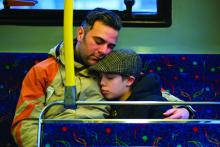User login
(Larissa MacFarquar, Aug. 7 & 14, 2017). It is a very complex question, and one for which there has never been an easy answer, certainly not an answer that can be applied universally. However, my reflex response was “sooner rather than later!”
What prompted my hasty from-the-hip answer is 40-plus years of watching the legal system grind along at a pace that too often fails to take into account the emotional needs of a child’s developing personality. While lawyers file for extensions and wait for slots in dockets bloated with less time-sensitive cases, children float in limbo waiting to hear where their home will be and who will constitute their family.
Even if he is lucky enough to be housed with a single foster home, the odds are that his stays there will be punctuated with returns to his parent as the parent is given one more chance to beat back the demons that have stood in the way of at least an adequate, if not a model, parenthood. The New Yorker article chronicles one such odyssey that spans a mother’s four pregnancies with several fathers.
In the crudest terms, here is the question: “How many strikes does one get before one loses his or her parental rights?” It is a bit easier to make the call when there have been incidents in which a parent’s action or inaction has put the child’s physical health in jeopardy. However, the social workers, physicians, and law enforcement officials who must shoulder the burden of these decisions involving the abusive parent often find themselves in no-win situations. Giving the parent who is suspected of physical abuse having been “just a little heavy handed” one more chance could result in death or life-long impairment.
I suspect the rationale for giving the parent another chance is based on the belief that the biologic family should always be the preferred option; an assumption that can be called into question. While I don’t think these decisions should be made with the strict application of an algorithm, I believe there is more room for evidence-based decision-making. That evidence may not be currently available, but I think we should be asking questions to get that information. For example, for an individual with a specific substance addiction or mental illness with a certain diagnosis, what are the chances of a remedy that will allow that individual to become a functional parent? And how long will it take?
Information like this may be helpful for those folks with the difficult job of deciding when a parent should lose his parental rights in a time course that takes into account the emotional needs of his children.
Dr. Wilkoff practiced primary care pediatrics in Brunswick, Maine, for nearly 40 years. He has authored several books on behavioral pediatrics, including “How to Say No to Your Toddler.” Email him at [email protected].
(Larissa MacFarquar, Aug. 7 & 14, 2017). It is a very complex question, and one for which there has never been an easy answer, certainly not an answer that can be applied universally. However, my reflex response was “sooner rather than later!”
What prompted my hasty from-the-hip answer is 40-plus years of watching the legal system grind along at a pace that too often fails to take into account the emotional needs of a child’s developing personality. While lawyers file for extensions and wait for slots in dockets bloated with less time-sensitive cases, children float in limbo waiting to hear where their home will be and who will constitute their family.
Even if he is lucky enough to be housed with a single foster home, the odds are that his stays there will be punctuated with returns to his parent as the parent is given one more chance to beat back the demons that have stood in the way of at least an adequate, if not a model, parenthood. The New Yorker article chronicles one such odyssey that spans a mother’s four pregnancies with several fathers.
In the crudest terms, here is the question: “How many strikes does one get before one loses his or her parental rights?” It is a bit easier to make the call when there have been incidents in which a parent’s action or inaction has put the child’s physical health in jeopardy. However, the social workers, physicians, and law enforcement officials who must shoulder the burden of these decisions involving the abusive parent often find themselves in no-win situations. Giving the parent who is suspected of physical abuse having been “just a little heavy handed” one more chance could result in death or life-long impairment.
I suspect the rationale for giving the parent another chance is based on the belief that the biologic family should always be the preferred option; an assumption that can be called into question. While I don’t think these decisions should be made with the strict application of an algorithm, I believe there is more room for evidence-based decision-making. That evidence may not be currently available, but I think we should be asking questions to get that information. For example, for an individual with a specific substance addiction or mental illness with a certain diagnosis, what are the chances of a remedy that will allow that individual to become a functional parent? And how long will it take?
Information like this may be helpful for those folks with the difficult job of deciding when a parent should lose his parental rights in a time course that takes into account the emotional needs of his children.
Dr. Wilkoff practiced primary care pediatrics in Brunswick, Maine, for nearly 40 years. He has authored several books on behavioral pediatrics, including “How to Say No to Your Toddler.” Email him at [email protected].
(Larissa MacFarquar, Aug. 7 & 14, 2017). It is a very complex question, and one for which there has never been an easy answer, certainly not an answer that can be applied universally. However, my reflex response was “sooner rather than later!”
What prompted my hasty from-the-hip answer is 40-plus years of watching the legal system grind along at a pace that too often fails to take into account the emotional needs of a child’s developing personality. While lawyers file for extensions and wait for slots in dockets bloated with less time-sensitive cases, children float in limbo waiting to hear where their home will be and who will constitute their family.
Even if he is lucky enough to be housed with a single foster home, the odds are that his stays there will be punctuated with returns to his parent as the parent is given one more chance to beat back the demons that have stood in the way of at least an adequate, if not a model, parenthood. The New Yorker article chronicles one such odyssey that spans a mother’s four pregnancies with several fathers.
In the crudest terms, here is the question: “How many strikes does one get before one loses his or her parental rights?” It is a bit easier to make the call when there have been incidents in which a parent’s action or inaction has put the child’s physical health in jeopardy. However, the social workers, physicians, and law enforcement officials who must shoulder the burden of these decisions involving the abusive parent often find themselves in no-win situations. Giving the parent who is suspected of physical abuse having been “just a little heavy handed” one more chance could result in death or life-long impairment.
I suspect the rationale for giving the parent another chance is based on the belief that the biologic family should always be the preferred option; an assumption that can be called into question. While I don’t think these decisions should be made with the strict application of an algorithm, I believe there is more room for evidence-based decision-making. That evidence may not be currently available, but I think we should be asking questions to get that information. For example, for an individual with a specific substance addiction or mental illness with a certain diagnosis, what are the chances of a remedy that will allow that individual to become a functional parent? And how long will it take?
Information like this may be helpful for those folks with the difficult job of deciding when a parent should lose his parental rights in a time course that takes into account the emotional needs of his children.
Dr. Wilkoff practiced primary care pediatrics in Brunswick, Maine, for nearly 40 years. He has authored several books on behavioral pediatrics, including “How to Say No to Your Toddler.” Email him at [email protected].


